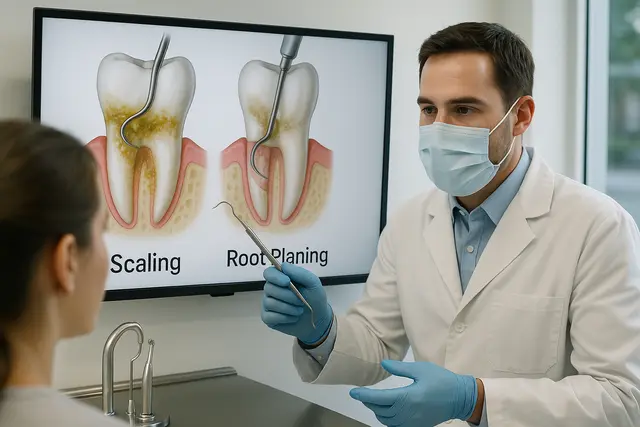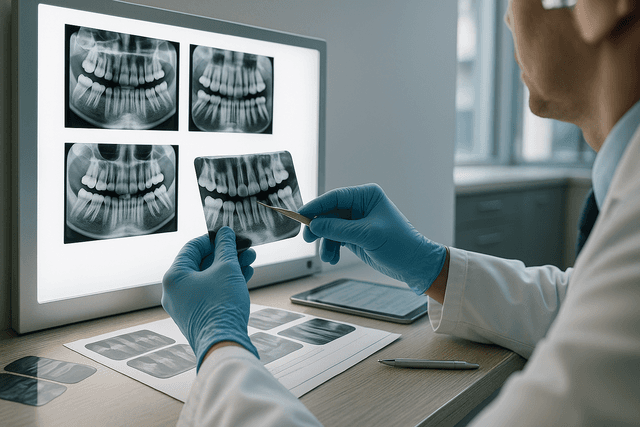General Dentistry
5 min read
Sep 10, 2025
What Is SRP in Dentistry? A Complete Guide to Scaling and Root Planing
When it comes to dental health, most people think regular cleanings are enough to keep their smile safe. But sometimes, what’s happening below the gumline needs more attention. Scaling and root planing (SRP) is a treatment designed to address gum disease at its source, protecting both your gums and teeth from long-term damage.

Let’s talk about teeth. Or more specifically, gums. Because when your dentist says you need an SRP, they’re not talking about some obscure dental code you can ignore. SRP stands for scaling and root planing, and while it might sound intimidating (or like something involving power tools), it’s actually a deep clean that saves your smile.
If you've been told you need this treatment, you're probably wondering why regular cleanings aren't enough, what the SRP procedure involves, and whether your gums are secretly plotting to betray you. Good news: we're here to explain everything clearly, with a little warmth and maybe a laugh or two.
Scaling and Root Planing Is More Than Just a Fancy Dental Cleaning
You’ve had your regular dental cleanings every six months like a champ, so what gives? Why now the SRP talk?
Here’s the deal: when plaque and tartar sneak below the gum line and hang out too long, they invite bacteria to throw a gum-inflaming party. That’s where gum disease begins. And once it reaches a certain point, brushing, flossing, and your average cleanings just won’t cut it.
Scaling and root planing is a deep dental cleaning designed specifically to treat periodontal disease. Think of it as a reset button for your gums and the roots of your teeth. Instead of only cleaning the visible parts of your tooth, SRP goes below the gumline, targeting the root surfaces to remove plaque and calculus that’s hard to reach otherwise.
SRP Is Your Gum’s Best Friend When Things Go South
If your gums are red, puffy, bleeding when you brush your teeth, or you've noticed your teeth feel a little loose, these may be signs of gum disease. That’s when your dental provider might recommend an SRP.
Gum disease, especially in its early stage (gingivitis), might seem harmless, but left untreated it can turn into periodontitis. That’s the more advanced gum disease where gum pockets form, the bone supporting the teeth begins to wear away, and tooth loss becomes a real risk.
Scaling and root planing steps in as the go-to treatment for periodontal disease before things get worse.
Cleanings Aren’t All Created Equal
A regular cleaning is a nice polish and shine. But an SRP? That’s where things get serious. This isn’t a quick swoop in and out. Planing is a deep cleaning that involves a few more steps, a bit more time (typically one to two hours per quadrant), and a much deeper reach.
During SRP, your dentist or hygienist uses special tools, like a scaler or even an ultrasonic device, to remove plaque and calculus (also known as tartar) from below the gumline. That’s the scaling part. Then, they’ll smooth out the root surfaces. Why? So bacteria have a harder time reattaching. That’s the root planing part.
The SRP Procedure Isn’t Scary
Let’s clear the air: no, the SRP procedure isn’t painful. It might sound like something from a horror movie, but in reality, you’ll likely get a local anesthetic to numb the area. That means you’ll feel pressure, not pain. You might even catch a little nap if you’re the brave type.
Typically, SRP is done per quadrant (that’s one-fourth of your mouth), sometimes over two visits or more depending on how deep the pockets are and how much work needs to be done. It’s not a one-size-fits-all situation, and a good dental professional will tailor the plan to you.
Why You Might Need a Deep Cleaning Even If Your Teeth Feel Fine
One of the sneakiest things about gum disease is that it doesn’t always come with glaring signs. You could have deep pockets of bacteria underneath the gums without any pain at all. That’s why dental visits and x-rays matter.
A dentist removes more than just surface debris. They’re trained to spot early signs of infection in the gums, tooth and root damage, and pocket depth. If your hygienist or dentist tells you that you need a deep cleaning, they’re not upselling you. They’re trying to help you avoid bone loss, teeth sensitivity, and yes, potential tooth loss.
The Symptoms of Gum Disease You Should Never Ignore
Even if you brush and floss religiously, some symptoms are worth a second opinion. Watch for:
Bleeding gums when you brush your teeth
Persistent bad breath (that mint can’t fix)
Gums pulling away from your teeth
Visible tartar from below the gumline
Red or swollen gum tissue
These aren’t just cosmetic issues. They’re signs your gums need some TLC, stat.
After Your SRP, Cleanings and Good Oral Hygiene Are Your New Best Friends
Once you’ve had your SRP, your dentist will likely recommend regular periodontal maintenance rather than standard dental cleanings. This means coming in more frequently (every three to four months) so your dental provider can keep your gums in tip-top shape and prevent bacteria from throwing another party.
Keeping up with oral hygiene at home matters more than ever. Brush your teeth at least twice a day, floss daily (yes, really), and skip the snacks that feed plaque and tartar buildup.
And hey, if you’re not sure whether you’re using the right technique or toothbrush, ask your hygienist. They love that stuff.
Dental Insurance and the Value of Treating Gum Disease Early
Now, the money talks. Yes, SRP can cost more than your regular dental cleaning. But most dental insurance plans cover scaling and root planing, especially if it's medically necessary (which it usually is if recommended). The cost of avoiding it? Think dental implants, bridges, or dentures. Not cheap. Not fun.
Addressing gum health early with an SRP can actually save you money and teeth down the line. And nothing beats the real deal, especially when you’re considering options like dental implants post-gum disease.
What Is SRP in Dentistry?
SRP stands for scaling and root planing, which is a deep cleaning procedure designed to treat gum disease. Unlike a standard cleaning that only removes plaque from the visible surfaces of teeth, SRP targets bacteria and tartar buildup below the gumline. The scaling part removes plaque and calculus from deep pockets, while the root planing smooths root surfaces so bacteria cannot easily reattach. This makes it a critical treatment for stopping gum disease before it progresses further.
When Do Dentists Recommend Scaling and Root Planing?
Dentists recommend SRP when signs of gum disease are present, such as bleeding gums, persistent bad breath, gum recession, or loose teeth. Even if you don’t feel pain, hidden bacteria can create deep pockets under the gums that regular cleanings cannot reach. By performing SRP early, dentists aim to prevent bone loss, tooth mobility, and eventual tooth loss caused by untreated periodontal disease.
Is the SRP Procedure Painful?
The procedure is not typically painful because dentists use local anesthetic to numb the treatment area. Patients may feel some pressure or vibrations from the instruments but not sharp pain. Depending on the severity, SRP may be performed in sections (often one quadrant at a time) and may take one or more visits. Afterward, mild soreness or sensitivity is normal, but it usually subsides within a few days with proper aftercare.
Does Dental Insurance Cover Scaling and Root Planing?
Most dental insurance plans cover SRP because it is considered medically necessary for treating periodontal disease, not just cosmetic. Coverage often includes a significant portion of the cost, though patients may still be responsible for copays or deductibles. Without insurance, SRP costs more than a regular cleaning, but it is far less expensive than advanced treatments like implants, bridges, or dentures that may become necessary if gum disease is left untreated.
Read Next
Related Posts

General Dentistry
How to Stop Nerve Pain in Tooth: Fast Relief That Works
Tooth nerve pain can be one of the most intense and disruptive types of discomfort. It often strikes without warning and makes everyday activities like eating, drinking, or even talking feel unbearable. Understanding what causes this pain and how to manage it effectively is key to getting fast relief.
4 min read
Sep 15, 2025

General Dentistry
Can a Sinus Infection Make Your Jaw Hurt? Understanding the Connection
Jaw pain can be unsettling, especially when it seems to appear out of nowhere alongside a stuffy nose or headache. Many people are surprised to learn that sinus infections can cause discomfort that feels like it’s coming from the jaw. Understanding the connection between your sinuses and jaw pain is key to getting the right treatment.
5 min read
Sep 15, 2025

General Dentistry
How to Read Dental X-Rays: A Visual Guide to Oral Health Clues
Dental x-rays may look like abstract black-and-white images, but they play a powerful role in uncovering what's really going on beneath the surface of your smile. From detecting hidden cavities to revealing signs of gum disease, these diagnostic tools are essential for maintaining oral health and catching problems early.
6 min read
Sep 10, 2025
Don’t have time to research every dentist around you?
See why 30k+ patients trusted us